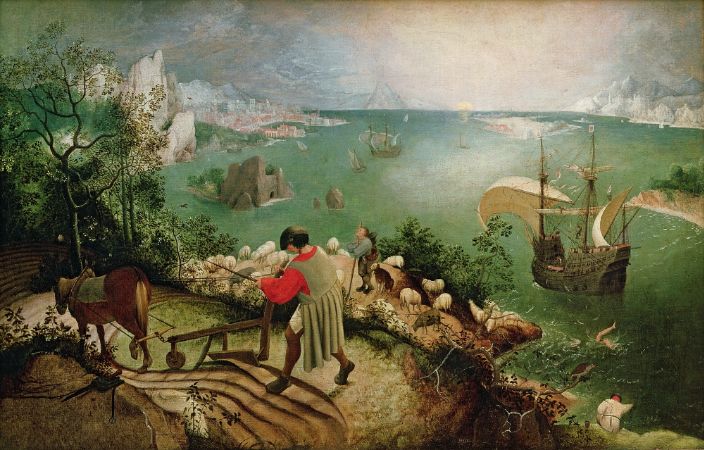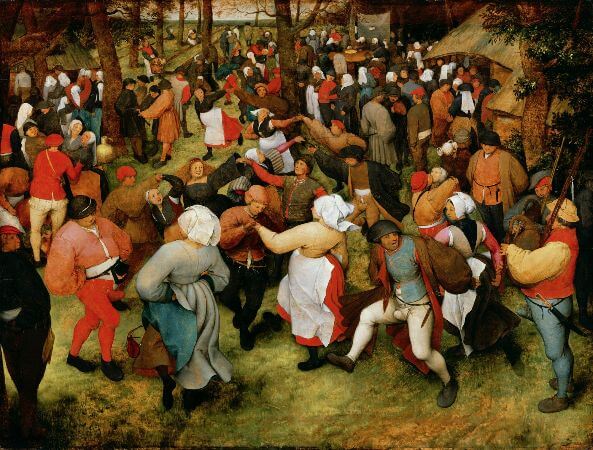The founding father of a four-generation painter dynasty: Who is Pieter Bruegel the Elder?
It was not fully understood how different of a talent Bruegel had from the 16th to the 19th centuries, it was thought that he was imitating other painters, only the impressive eccentricity of the peasant figures was appreciated. It was too late to realize Bruegel's genius.

Pieter Bruegel (or Brueghel), also known as De Oudere or Boeren Bruegel, is a Dutch painter and engraver, nicknamed Peasant Bruegel, Old Bruegel, Baba Bruegel to distinguish him from his sons and grandchildren who were painters like him.
Bruegel was born in Breda, Flanders in 1525, according to the book Het Schilder-boeck (Book of Painters) dated 1604, in which Flemish painter Karel Van Mander wrote biographies of Flemish artists. However, it is controversial whether this city is the city of Breda within the borders of the Netherlands or the city of Bree within the borders of Belgium.
Pieter Bruegel (also Brueghel or Breughel) the Elder 1525–1530 – 9 September 1569) was the most significant artist of Dutch and Flemish Renaissance painting, a painter and printmaker, known for his landscapes and peasant scenes (so-called genre painting); he was a pioneer in making both types of subject the focus in large paintings.
He became a student of the painter, sculptor, architect, tapestry, and stained glass artist Pieter Coecke van Aelst, who traveled to Italy and Ottoman Istanbul in the 1530s. During this time, Bruegel was introduced to the philosophy of humanism for the first time, and through his master, he had the opportunity to enter the leading Flemish humanist intellectual circle of the time.
Pieter Bruegel settled in Antwerp, Belgium, one of the important centers of the Flemish Renaissance, and was accepted as a master in the St Luke's Guild, the city's painters' guild, in a short time.
Between 1551 and 1552, Pieter Bruegel went on a long trip to Italy. The painter, who reached northern Italy and then went beyond Naples to the city of Palermo on the island of Sicily, documented the landscapes on the roads he passed, with many drawings, engravings, and paintings depicting mountains and valleys, especially with their wild nature. Bruegel, who went to Rome in 1553, worked for a while with Giulio Clovio, one of the important miniature painters of the period, making oil paintings and drawings as well as a joint miniature work.
We see Bruegel as a landscape painter. However, Bruegel's landscapes transcend the tradition of both 16th-century Flemish and Titian and Venetian landscape masters, taking the art of landscape to new dimensions. Although Bruegel showed that he had a wide and unique repertoire in terms of subject and image throughout his artistic life, a vast landscape of nature, which can be called almost impressionist and even expressionist, will become an element that can be identified in his paintings.
Returning to Antwerp in 1555, Bruegel entered into an intensive production activity over a period of about 10 years. The earliest examples from this period documenting Bruegel's process of creating his distinctive themes and style are a series of drawings depicting the Alpine region, dated between 1553 and 1556. Although a small portion of these drawings were drawn during the artist's trip to Italy, most are thought to have been created after his return to Antwerp. These patterns, most of which he sketched during his travels, and which are composed of free compositions in line with the impressions of the artist's road experiences, show how the artist was influenced by the wild, magnificent, and picturesque atmosphere of the mountains.

In this period, the art of engraving was rapidly becoming popular in Central Europe with the spread of the printing press. Engravings were widely used propaganda material by religious factions, philosophical movements, and political groups. Working with Hieronymus Cock, a publisher and engraver from Antwerp, Bruegel has produced more than forty engravings since 1556.
Although initially influenced by Hieronymus Bosch's engravings, Bruegel later created his own style, producing a wide range of original works from didactic, political, and moral subjects to parables, humorous stories, religious scenes, and landscapes until 1563. Bruegel's engravings also made his name heard by the masses for the first time.
In Bruegel's paintings, the main situation is often depicted as an insignificant detail and is placed in a corner of the picture or is lost in unity with other areas.
One of the best-known examples of Bruegel's unconventional and ingenious way of translating moral issues into colloquial speech is his painting Netherlandish Proverbs. This painting by Bruegel, which brings together more than 100 proverbs and aphorisms suitable for the language of the local people, through this painting and on this scale, in the 16th century Flemish village setting, is one of the artist's most popular works. The common feature of the illustrated proverbs and idioms is that they make fun of people's stupidity. Bruegel makes his works almost three-dimensional, even multidimensional, with just pencil, brush, paint, and his age-old creativity.
Pieter Bruegel married Mayken Coecke, who was the daughter of his teacher Pieter Coecke van Aelst and Maria Verhulst Bessemers, in Brussels in 1563. The painter's leaving Antwerp and moving to Brussels, where his wife's family lives, is an important turning point in his art as well as in his life. Pieter Bruegel, who left the engraving design completely aside and concentrated on painting oil paintings in Brussels, created his most important works during this period.
The painter, who died in Brussels on September 9, 1569, was buried in the garden of Notre Dame de la Chapelle, the church he married. Pieter Bruegel became the founding father of a four-generation painter dynasty that would last well into the 18th century, which included important artists such as his grandsons Ambrosius Bruegel, Jan Bruegel the Younger and David Teniers, and his great-grandson, Abraham Bruegel.
However, it was not fully understood how different of a talent Bruegel had from the 16th to the 19th centuries, it was thought that he was imitating other painters, only the impressive oddity of the peasant figures was appreciated. These comments were made on Bruegel's engravings seen in the middle. Bruegel's genius and value became more apparent as his meticulously made paintings in the warehouses of aristocratic collectors came to light.
